178 posts
Latest Posts by green-notebooks - Page 5
Tiny Houses in Urban Context
I’ve seen a lot of really great tiny home designs, and I’ve seen a lot of love from other people for those designs as well. They combine a small space, perfect for one or two people, that usually only apartment buildings design for, with the benefits of having a detached home, with a yard, and windows on all sides for more natural light.
What I don’t see is a whole lot of context, least of all in an urban neighborhood environment. These houses are often pictured in an open grassy, or forested space, which is nice for some people I’m sure, but there are lots of people who would prefer to live in a city, in pedestrian and transit friendly areas, rather than in the middle of nowhere, where you’d have to use a car to get everywhere.
There already exists an urban context for tiny homes, but due to restrictive zoning, it’s not commonplace in most cities in the U.S.
They’re called Bungalow Courts, or sometimes Cottage Courts, and basically it’s where you take two adjacent lots, and rather than having one large single-family-house per lot, you have around 3 or so tiny houses per lot, all facing a shared space in the center.

All this takes up the same space as two city lots, which are usually zoned to only allow one house per lot. But not everyone wants, or can afford a large house, so Bungalow Courts would be a perfect fit in a lot of neighborhoods that currently lack a lot of housing diversity for a range of wants and needs.



Anyway, I just thought I’d share, because I think this a really neat concept that should be allowed more places. I’d think I’d like to live in a Bungalow Court; I like the idea of having a house to myself, but I don’t need much space, and I don’t want a huge yard to maintain.
In order to make this legal to build out, zoning would need to be changed to allow 3-4 units of housing to be built on lots currently restricted to only 1 unit of housing. A big contributing factor to rising housing costs has been the over-favoring of single-family houses on large lots since the end of WWII, so not enough units of housing are being built in many cities to keep up with demand.
Legalizing more “missing middle housing” like Bungalow Courts in single-family-house-neighborhoods would help cities incrementally keep up with demand, in a way that fits nicely into existing neighborhoods.
considering doing the 100 days of productivity to help me get back into the swing of university 🤔🤔 anyone wanna share tips?






Source.

Vegans of tumblr, listen up. Harvesting agave in the quantities required so you dont have to eat honey is killing mexican long-nosed bats. They feed off the nectar and pollinate the plants. They need the agave. You want to help the environment? Go back to honey. Your liver and thyroid will thank you, as well. Agave is 90% fructose, which can cause a host of issues. Bye.
Fun fact, hammering metal spikes into tree trunks is a federal crime in the US because environmental activists used to do it in the 80s to fuck up chainsaws and logging equipment.
Succulent Care Guide
I see a lot of people killing their succulents due to ignorance of how to care for them. Here’s a quick guide!
Lighting: Most* succulents require full sun, meaning they need direct sunlight for 4-6+ hours a day. South or west-facing windows are ideal for succulents. You can also move your succulent around windows throughout the day to give as much light as possible, if you want.
If your succulent has previously not received enough light, GRADUALLY give it more and more sun over two weeks. This will prevent sunburn.
Failure to give your succulent proper lighting will result in etiolation – a process in which your plant will grow lanky, weak stems in an attempt to find more light.
If you can’t provide enough light, succulents probably aren’t right for you. Look into lower light plants, such as pothos or peace lily!
Type of Pot: Succulents need a pot with a drainage hole. End of story. No rocks in the bottom will help, no bullshit. Drainage. Hole.
Size of Pot: Pick a pot no more than one inch larger than your plant’s rootball. Overpotting will kill your plant. Oversized pot = too much soil = more water than your plant can use = death from root rot.
Soil: Regular potting soil is terrible for succulents as it’s water-retentive. Succulents like well-draining soil with lots of perlite or pumice, and gritty ingredients such as fine bark or turface. Look for a cactus&succulent soil mix, or just improve regular soil by adding 50% perlite. Avoid anything with peat moss! Avoid MiracleGro.
Time to Water: Find a wooden toothpick for small pots, or a wooden dowel for larger ones. Insert the wood into the soil. If it comes out wet, with damp soil sticking to it, it’s not time to water yet. If it comes out clean and dry, your succulent is thirsty! Think of checking brownies with a toothpick to see if they’re done baking.
This is recommended because often times your finger cannot feel the soil towards the bottom of the pot, and you need to make sure all of the soil is dry before watering.
DO NOT WATER ON A SCHEDULE. DO NOT RELY ON A WETNESS METER (THEY ARE INEFFECTIVE). DO NOT WATER DAILY. Listen to your plant!
How to Water: When your succulent’s soil is dry, water thoroughly, until water drains out of the drainage hole. Allow all excess water to drain before putting it back into any saucers or decorative pots.
*Some succulents’ lighting needs may vary – such as Haworthias with “windows” in their leaves, who don’t like as much sun, or Sempervivums who need much more sun than most. Look up your specific plant’s care to be sure!

Jeanette Winterson
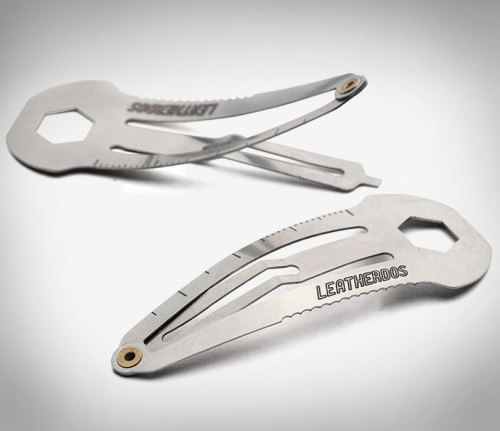
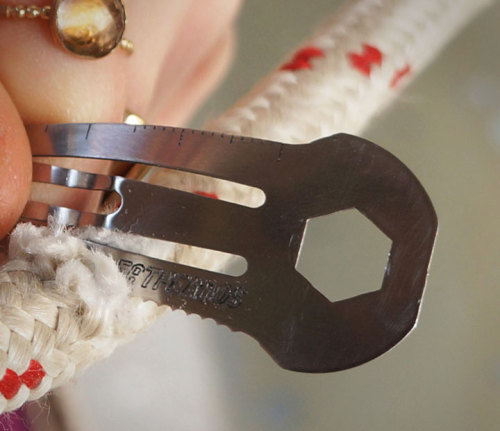
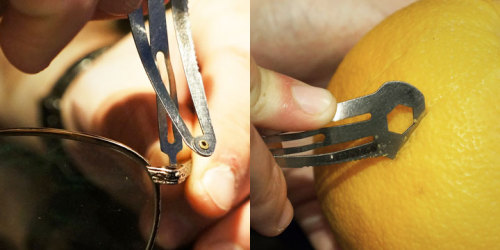
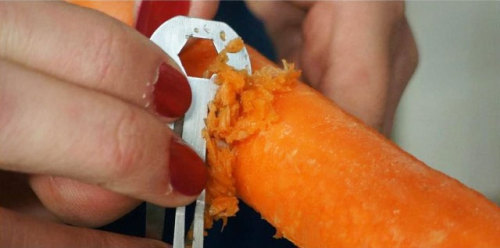
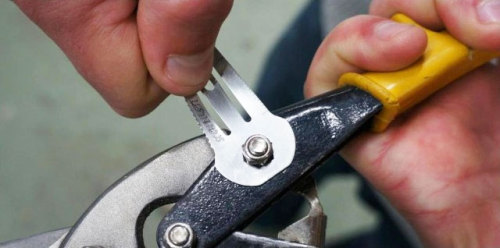
The Leatherdos is a hair clip that doubles as a multi-tool that combines 5 different tools in a tiny hair clip: screw-drivers, a wrench, a trolley coin, a ruler, and a cutting edge.
—->http://odditymall.com/leatherdos-is-a-hair-clip-multi-tool
Me, waking you up at two am: hey, do you ever think about how we live in a culture of rejecting our local “wild places” in favor of fetishizing and romanticizing the distant and different?
There’s this overwhelming rhetoric we’re fed that the only nature worth protecting is Grand and Huge and most of all Somewhere Else.
Nobody thinks about the wetland behind their local Walmart that is in Desperate need of protection, or the little remnant prairie in a cemetery, because they’re too focused on the abstract and often flawed concept of “wilderness” somewhere else.
There is nothing wrong with wanting to travel to see something new and unique, but the way I hear people talk about our own backyard, the way the last remnants of what we have here are ignored or outright rejected, breaks my heart.
My professor has spent his entire career in the Midwest trying to protect wetlands from housing developments and new superstores, but he almsot always loses, not just because the developers have money, but the community doesn’t care enough to do anything about it.
Afterall, what’s a few old oak and birch trees in a little puddle of a swamp compared to miles of marsh in Scandinavia? What’s a grassy hill to a distant mountain range?
Well, to the duck, to the heron, to the bluebird, and to precious few people, I’d say it’s Everything.
I love to travel myself, and I know people probably don’t know that when they say “why is our wildlife/plant life etc. so lame” that they’re contributing to an attitude of rejecting what unique beauty we do have,
But
I hope one day people can see the wonder nearby and fight to protect it. I hope there’s something left to protect.
Anyway…..where do u keep your cups I want some water.
Can't afford to buy things for your garden?
*Re-posting, with new information
A store-bought bag of topsoil, a roll of landscaping fabric, or a bag of cedar chips doesn’t go very far if you have a large garden or a very limited budget. Here are some ways to create the materials you need for a beautiful, organic, productive garden, by both re-directing household waste, and foraging in your local area. I use a lot of these tricks in my garden to make it almost completely free for me to continue growing new things, and expanding the workable area every year!
For soil
Save your food scraps to create a rich compost for growing veggies and amending your soil. There are numerous options for every size of dwelling and yard. Small space solutions such as Bokashi and vermicompost work indoors and don’t produce bad smells, so you can keep them underneath the sink.Worm towers, compost heaps, and outdoor compost bins are a great solution if you have more space. The more you add, the more rich, nutritious material you can make for your garden. I like composting because it means I don’t have gross smelly garbage bags to deal with, because food waste is diverted. It seems like a lot of work at first, but it actually saves time, money, and transportation.
Seaweed or kelp is one of the best things for your garden, with over 70 essential nutrients, and acting as a weed barrier and a moisture-retentive mulch. I collect seaweed nearby on the beach with my bike trailer, or, when I go for a walk I bring a little home with me each time. It’s an absolute miracle for your soil.

Worm tower
Fertiliser
There are three things that are essential for plant growth. These are nitrogen for leaves and vegetation (N), phosphorus for roots and shoots (P), and potassium for water movement, flowering, and fruiting (K). Commercial fertilisers will give the relative concentrations of each of these compounds with and “NPK” rating. Plants like tomatoes also need calcium to produce healthy fruit. You can create amendments for your garden and soil at home so that you do not have to purchase fertiliser.
For nitrogen
Grass clippings contain 4% nitrogen, 1% phosphorus, and 2% potassium (NPK = 4-1-2).
Human urine contains 12% nitrogen, and it’s sterile. Dilute before adding directly to plants.
Legumes such as beans, clover, peanuts, and alfalfa fix inorganic nitrogen into the soil with mycorrhizal organisms and nodules on their root systems. Plant these crops every few years in rotation with others to renew the soil organically.
For phosphorus
Human urine is also a great source of phosphorous and trace amounts of potassium.
Ground up bones or shells add a slow-release phosphorous to the soil
Had a baby recently? Bury the placenta in the garden.
For potassium
Hardwood ashes
Composted banana peels
For calcium
Break down all of your eggshells, or seashells you have found, in a plastic bucket, using vinegar. This creates a soluble calcium solution you can add to a watering can.
Soil Acidity/Alkalinity
Many plants are particular about what the soil pH should be.
To make soil more acidic: add oak leaves, pine needles, leaf mulch, urine, coffee grounds or sphagnum.
To make soil more alkaline: add wood ash, shell, or bone.
Mulch
Mulch is decomposing organic matter that adds nutrition to the soil, while simultaneously keeping out weed growth and retaining moisture. It also attracts worms, fungi and other beneficial creatures to your soil. Free sources of mulch include:
Leaves
Garden waste
Grass clippings
Straw (often straw bales are given away after being used for decoration in the fall. You can also plant vegetables directly in straw bales using a technique called straw bale gardening).
Wood chips (if you can borrow a wood chipper after you’ve collected some wood you can have attractive wood mulch for free)

Straw bale garden
Landscaping fabric
When mulch isn’t enough to keep the weeds down, many people opt for landscaping fabric. It can be quite expensive and inorganic-looking. Free solutions that both attract worms and can be replaced in small segments as they break down include:
Newspaper*
Cardboard*
Egg cartons*
Printer paper, looseleaf, etc. in thick layers*
*try to make sure you are using paper that has vegetable-based dyes, so you aren’t leeching toxins into the soil.
Soil density/drainage
If your soil is compacted and you have plants that require low levels of water, or excellent drainage, add sand. I don’t recommend stealing it from the beach, but ask around and you’d be surprised at how easy it is to get for free. Sawdust also improves drainage. Adding organic matter and mulch encourages worms, who also till and aerate compacted soil.
If the area still needs drainage, dig a hole and fill it with bricks or rocks to create a “dry well”
For drainage in pots, add crushed bricks, terra cotta pot fragments, packing peanuts, small stones, marbles, orsand to the bottom under the soil layer. I find these in construction sites, on craigslist, or at flea markets.
Pots and growing containers
If you have space, raised beds are a great no-dig way to establish growing space. If you are pressed for space (like working on a balcony) there are many cheap or free options for container gardens.
Creating raised beds allows you to build up the soil without digging. Free ways to do this include using rocks or lumber (like my DIY “lasagna garden” made with the sheet composting technique), using the “wattle“ method with sticks and posts you have found, using discarded straw bales, old bricks,paving stones, cinder blocks or really anything else you have lying around.
Hugelkutur raised beds, which fix carbon and provide drainage, can be made by stacking sticks and untreated wood, and then piling soil or compost over it. (Thanks milos-garden)
Rubber tire gardens retain heat in the night and allow for great drainage. They can also be painted in fun ways.
Herb spirals (here is mine: 1, 2, 3) can be built with stones, bricks, and other found materials.
I often use old cooking pots, barbecues, teapots, or other found objects as planters.
Making wooden planters is easy, and scrap or salvaged wood is also easy to come by. I’m not a fan of using wooden pallets for DIY projects, but they are also a free source of lumber for things like planters.
If you can track down peat moss, cement, and vermiculite, you can make an easy Hypertufa planter in whatever shape you would like, provided you have a form in which it can dry.
I’ve made hanging gardens out of soda cans.
You can build a self-watering container with a 2L pop bottle.
Start seeds in eggshells
Make biodegradable pots out of newspapers.
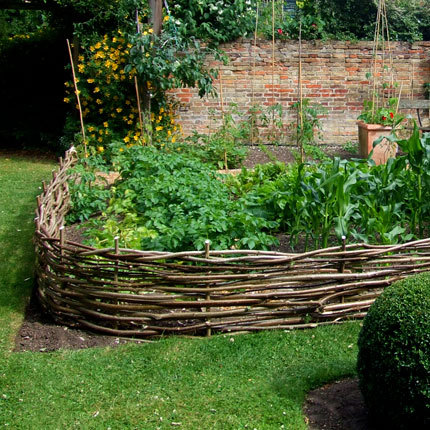
Wattle raised beds

Rubber tire gardens

Hugelkultur

An herb spiral
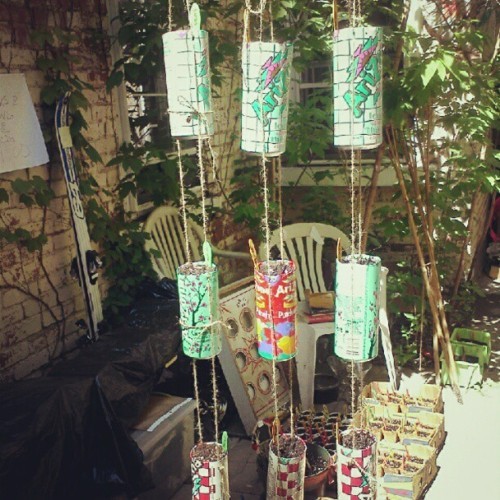
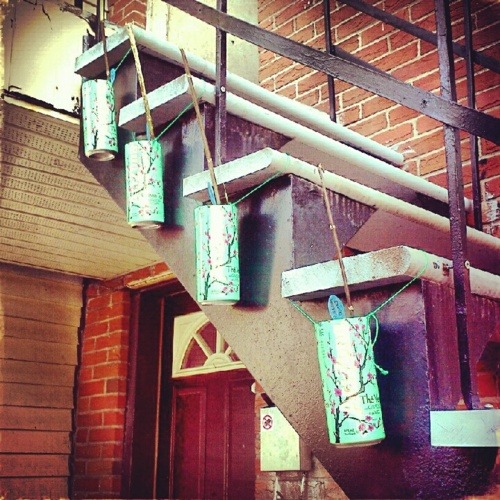
Hanging gardens in cans (2)
Trellises and supports
Many plants need external support, such as stakes of trellises, to thrive.
Rebar can almost always be salvaged cheaply or free and makes a great trellis, arch, or purgola
Build trellises and supports out of the pliable young stems of plants like willow
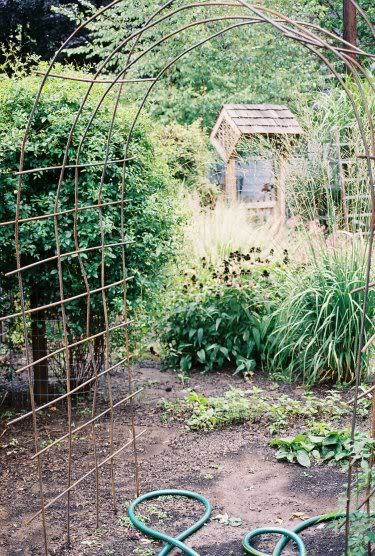
Rebar trellis/arch

Living willow arch/trellis
Paving
Paving often requires a foundation of sand or another stable and well-drained substrate, and a covering of stones, bricks, or other weatherproof elements. Slowly collect stones over time, or free paving stone fragments to create a mosaic-type walkway. Often people give these things away on craigslist. I made a patio and fireplace out of free salvaged bricks, for example.

Salvaged garden walkway
Greenhouses and cold frames
Here is a gallery of greenhouses made out of salvaged windows and doors
A cold frame is easy to make with salvaged lumber, and plastic sheeting.
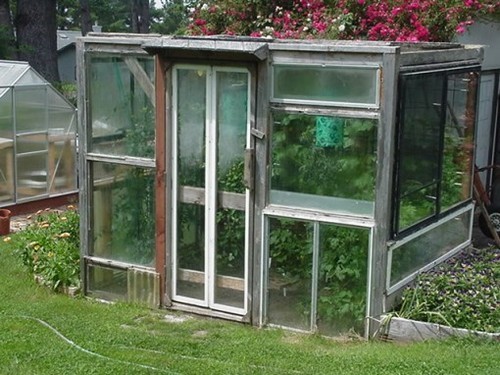
Window greenhouse
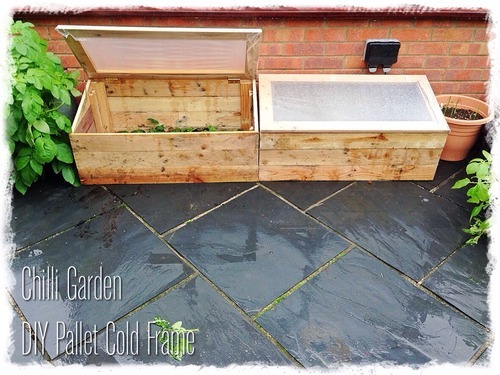
Palet cold-frame
Seeds and plants
Swap seeds with other gardeners
If you see a plant you like at someone’s house, ask for seeds or cuttings
Save seeds every year and build a library of options. Here is a great guide to seed saving.
Save seeds from foods you like from the grocery store: consider growing peanuts, ginger, garlic, peppers, or a walnut tree: all of these and more can be planted from store-bought produce.
Learn to take cuttings. There is a tonne of info on the web about basic cutting propagation, layering, (like I do with rhododendrons) air layering, and numerous other techniques to take clones of plants you like. This saves going to a nursery and shelling out big bucks for all the variety you want.
For cuttings, willow tea and honey are great rooting hormones/antiseptics/anti-fungal agents, which can save you $40 if you were thinking of buying commercial rooting hormone.
You can root cuttings in a potato! (See my methods for rooting “borrowed” plants here)
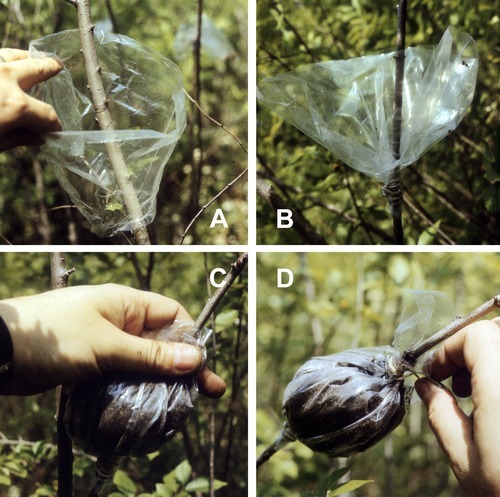
Air layering
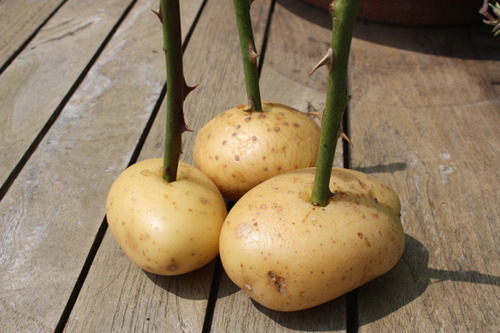
Rooting cuttings in potatoes
—-
I hope this helps you build your garden outside of the usual capitalist channels! It can be a cheap or free hobby if you are willing to think outside the box, and maybe put up with things that don’t look as clean or crisp as a hardware store catalogue. If you have any further ideas, please add them! The more information the better.
sustainability as a concept done on an individual basis shouldn’t be framed as planet saving because it’s. not. you can’t save the earth by planting your own tomatoes, because the destruction of the earth is due to corporations
what you CAN do is use individual sustainability to gain a level of independence from capitalism for yourself and for your community through things like sharing grown food
no, listen, when I say I want to integrate more specific solarpunk stuff in my life, i don’t mean to ask for yet again new “aesthetic” clothes that now you have to buy or make to show your support of the movement (screw that i’m consuming enough as it is), or more posts about impossible house goals, or whatever, I’m asking you what my options to build a portable and eco friendly phone charger are, im asking you viable tiny-appartment edible plants growing tricks on a budget, im asking tips to slow down when my mind and society tell me im not fast enough, i don’t need more rich art nouveau amateurs aesthetics or pristine but cold venus project, okay, i know i should joins associations where I am tho i’m constantly on the move, thanks for that, just, you know, can we get a bit more practical ??? how do I hack my temporary flat into going off the grid for the time i’m here
7 reasons why solarpunk is the most important speculative fiction movement in the last 20 years
It’s hopeful. Solarpunk doesn’t require an apocalypse. It’s a world in which humans haven’t destroyed ourselves and our environment, where we’ve pulled back just in time to stop the slow destruction of our planet. We’ve learned to use science wisely, for the betterment of ourselves and our planet. We’re no longer overlords. We’re caretakers. We’re gardeners.
Scientists are heroes again. And not just physicists and astronomers. Knowledge of biology and earth sciences matter, they’re the building blocks for a future on Earth. Scientific literacy isn’t just for academics – it’s part of daily life. People know how the things they use work, and if they don’t, they can access that information.
It’s diverse. Solarpunk is rooted in using the environment, so it looks different in different places. Alternative energy is best when specific to place (I imagine geothermal, wind, tidal, and hydroelectric energy sources are still used in certain places) so no overarching government system is needed. Communities can organize themselves, taking their own location and needs and history into account. Brazilian, Inuit, Egyptian, Pacific Northwest, and New Zealand solarpunk can all look very different, but be unified in resourceful, intentional, low impact living.
Individuality still matters. In a post-scarcity society, ingenuity and self-expression are not sacrificed on the altar of survival. With solar power there’s no reason not to go off grid, if that’s what you want to do. Communities can self-organize. You can find a community that suits you, or go live by yourself if that floats your boat.
There’s room for spirituality and science to coexist. Solarpunk is rooted in a deep understanding and reverence for natural processes. There’s room for spirituality there, be it pagan, Buddhist, Sufi, Transcendentalism – anything. There’s so much to explore, from nature worship to organized monotheistic religions, and how they interact with solarpunk.
It’s beautiful. The most common solarpunk aesthetic is art nouveau, but again there’s room for diversity, incorporating art styles from multiple cultures in respectful, non-appropriative ways. The most important aspect of solarpunk aesthetic is the melding of art and utility. The idea of intentional living is strong in art nouveau, but it’s not the only art movement with that philosophy.
We can make it happen. Now. Earthships. Permaculture. Aquaponics. Algae lighting. Compostable products that turn into fields of flowers. Buy Nothing organizations. Tiny, beautiful, efficient homes. Solar power cells you can see through. That’s all happening now. Solarpunk is within our grasp, at least on a personal level. I’m not saying there aren’t still big, ugly infrastructures devoted to unethical consumption, but we can start to tear them down. We can build a solarpunk world with stories and small changes. And small changes lead to big changes. That’s the real beauty of solarpunk. It’s not a post-apocalyptic power fantasy. It’s not a wistful daydream, or an elite future only for physicists. It’s something we can work towards right now. It’s tangible.

Hey solarpunk community! In light of several posts that have been going around, I was thinking it would be worthwhile to talk about the real, physical things we can do to make this world a more solarpunk place. Because speculation and aesthetics and thinkpieces are awesome, but a movement isn’t a movement without real action behind it. So what are things we can all do to make the present closer to our solarpunk future?
More on solarpunk education:
So I made a big post about cooperative, age-appropriate games as a solarpunk education method, but in my ideal solarpunk world that would only be one aspect of education. Here are some other education ideas bouncing around in my head. Like cooperative games, they all require a lot of time, knowledgeable teachers, and community investment, but I think they would lead to healthier, enthusiastic people, fully prepared to live well and be lifelong learners.
Food Science Education: Starting at a young age with simple gardening and cooking, stuff that young kids can get really excited about. As kids age, folding in the complete science of where food comes from, its relationship with the ecosystem, how to preserve it, and how to prepare it.The idea being that by the time you’re an adult you should have the tools to competently feed yourself even if you end up focusing on other things.
Relationship Education: An improvement on sex ed. Much of the same content, but expanded with more information for all genders and sexualities, and good, non-scare tactic science on the human body, reproduction, contraceptives, stds, and common communicable illnesses. Also, workshops on healthy relationship communication, self-care, meditation/introspection/self-knowledge, basic first aid, how to help friends in the midst of crisis or mental illness, how to recognize predatory/manipulative/abusive behaviors (in sexual situations and otherwise oh my god it’s so important, why aren’t we taught this early and often?), some basic childhood development stuff.
Artistic Expression & Upcycling: Art classes which would cover art theory and allow for a lot of self-expression, but would also teach young adults to make and repair their own clothing, use basic woodworking tools, work with ceramics, safely fiddle with metals and basic electronics, and other practical “specialty” skills necessary for a world with less waste.
Rotating Apprenticeships: Starting out as small group field trips for younger kids, and evolving into longer choice-based apprenticeships in areas of interest, maybe taking up one day per week for high school aged kids. The community members involved in this experience wouldn’t necessarily give lessons on their livelihood – for example a farmer with a deep knowledge of medieval history and geology could focus on one of those subjects if they chose. This would give adults in the community a chance to delve deeper into subjects they loved, and kids a chance to learn a subject from someone truly enthusiastic.
Questing/Journeyman years/other travel: I know there are plenty of posts on solarpunk travel, but in an educational context I imagine it as a continuation of rotating apprenticeships. This would be a time for young adults to visit people and places related to their areas of interest. It could be very specific (like meeting and working with 5 scientists on 5 continents while studying food sustainability) or a more general exploration (visiting some great museums, WOOFing, contributing to public art, and journaling about the experience while trying to decide what to do next).
Independent Project Salons: This would be a way to tie together celebration, community, and education. Informal salon settings would be a great place for young adults doing independent study or in the midst of travel to meet and talk about their experiences and ideas, and maybe show off their work. Possibly hosted by retired folks who could organize food and drink, introduce topics and guests, and add the benefit of their own experiences.
What other kinds of solarpunk educational programs do you love the idea of?
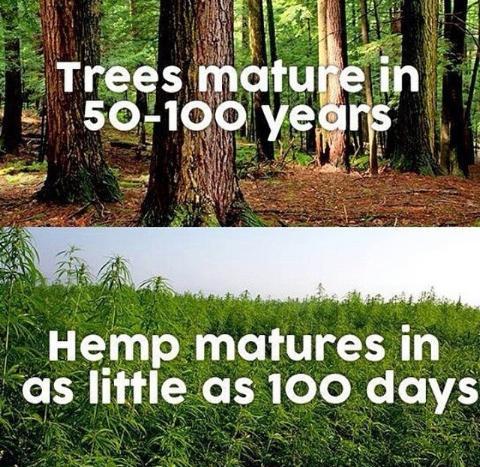
#SaveTheTrees
How much longer until the utopic Solarpunk future where Capitalism is dead and we all live in ecologically sustainable high-tech forest cities? Asking for a friend.
3-D printed bionic skin. It’s not science fiction.
follow @the-future-now
You know what line gets me every time I watch MAD MAX FURY ROAD?
“Do not, my friends, become addicted to water. It will take hold of you, and you will resent its absence.”
Think about that. “Addicted to water.” It makes it sound like water is an extra luxury that people don’t need but are greedy for, something they should be able to go without, and if they are desperate for it, it’s their own fault, and not the fault of the man who has all of it, and withholds it.
Think about how the people in power tell us not to be greedy for the things we need, like healthcare, like a living wage, like the right to be free of fear and violence in our own communities. The people in power tell us not to be greedy for these things, when they themselves already enjoy them freely, and withhold them from us.
Don’t trust the narrative that tells us we’re being greedy by asking for things that we need.
Don’t trust the asshole sitting on a grassy hilltop with his hand on the spigot telling us not to be greedy for water.
This Week @ NASA--April 14, 2017
Cassini and the Hubble Space Telescope, two of our long-running missions, are providing new details about the ocean-bearing moons of Jupiter and Saturn. Hubble’s monitoring of plume activity on Europa and Cassini’s long-term investigation of Enceladus are laying the groundwork for our Europa Clipper mission, slated for launch in the 2020s. Also, Shane Kimbrough returns home after 171 days aboard the Space Station, celebrating the first Space Shuttle mission and more!

Ocean Worlds
Our two long-running missions, Cassini and the Hubble Space Telescope, are providing new details about “ocean worlds,” specifically the moons of Jupiter and Saturn.

The details – discussed during our April 13 science briefing – included the announcement by the Cassini mission team that a key ingredient for life has been found in the ocean on Saturn’s moon Enceladus.

Meanwhile, in 2016 Hubble spotted a likely plume erupting from Jupiter’s moon Europa at the same location as one in 2014, reenforcing the notion of liquid water erupting from the moon.

These observations are laying the groundwork for our Europa Clipper mission, planned for launch in the 2020s.

Welcome Home, Shane!
Shane Kimbrough and his Russian colleagues returned home safely after spending 173 days in space during his mission to the International Space Station.

Meet the Next Crew to Launch to the Station
Meanwhile, astronaut Peggy Whitson assumed command of the orbital platform and she and her crew await the next occupants of the station, which is slated to launch April 20.

Student Launch Initiative
We’ve announced the preliminary winner of the 2017 Student Launch Initiative that took place near our Marshall Space Fight Center, The final selection will be announced in May. The students showcased advanced aerospace and engineering skills by launching their respective model rockets to an altitude of one mile, deploying an automated parachute and safely landing them for re-use.

Langley’s New Lab
On April 11, a ground-breaking ceremony took place at our Langley Research Center for the new Systems Measurement Laboratory. The 175,000 square-foot facility will be a world class lab for the research and development of new measurement concepts, technologies and systems that will enable the to meet its missions in space explorations, science and aeronautics.

Yuri’s Night
Space fans celebrated Yuri’s Night on April 12 at the Air and Space Museum and around the world. On April 12, 1961, cosmonaut Yuri Gagrin became the first person to orbit the Earth.

Celebrating the First Space Shuttle Launch
On April 12, 1981, John Young and Bob Crippin launched aboard Space Shuttle Columbia on STS-1 a two-day mission, the first of the Shuttle Program’s 30-year history.

Watch the full episode:
Make sure to follow us on Tumblr for your regular dose of space: http://nasa.tumblr.com










Lamp Plants by Mar de Fe on Etsy
See our ‘nightlights’ tag
Follow So Super Awesome: Facebook • Pinterest • Instagram
so i just heard about solarpunk today and i LOVE the idea.
Does the vertical garden in Milan count as something you could call “solarpunk”?


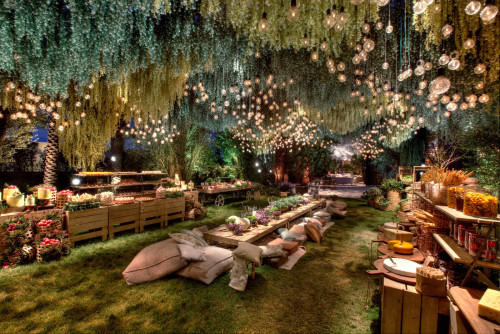

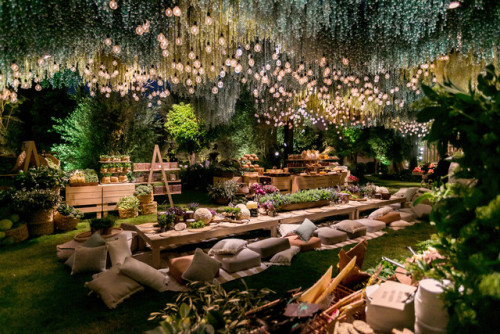
By Designlabexperience
This is truly incredible.
Btw I’m terrified and we are all gonna die and if I hear one more person say “our species destroyed the environment” I’m gonna lose it harder than I already am which is, for the record, Very Hard Indeed
You know of any examples of wintry Solarpunk?
I’m not sure how all of the logistics would work (I’m more of a sociology guy than a STEM guy), but I don’t see why a colder climate wouldn’t be able to take advantage of renewable energy sources – geothermal and perfected solar technology and such.
Aesthetically, you’d probably end up with something very similar to the “Northern Lights glass igloos” in Finland:




Maybe connect all the igloos with a tunnel/tube system and have them all link up to a big hub at the center. Maybe the hub has advanced solar panels and sits on a geothermal hot spot, and the energy accumulated there could power the surrounding homes and buildings.
People can and should add to this, because my winter solarpunk imagination is a tad limited.




